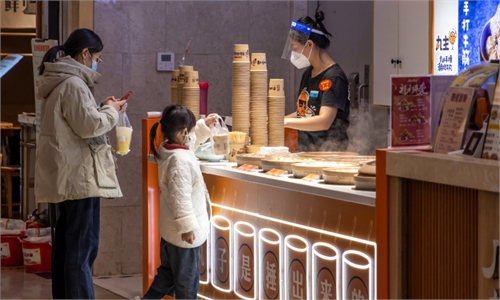Beijing releases two guidelines coaching residents and communities how to react to COVID infections

People shop in a Beijing market. Photo: CFP
How should residents and communities react to COVID-19 infections? Beijing health authorities on Thursday released two new guidelines for communities and residents who are confirmed positive for the virus while they quarantine at home, addressing common questions raised in the face of the country's continued optimization of its response to COVID-19.
On Wednesday the State Council's joint prevention and control mechanism against COVID-19 unveiled a new 10-point plan to further optimize the country's COVID-19 response, including allowing asymptomatic carriers and patients with mild symptoms and those who meet certain requirements to quarantine at home.
The two guidelines issued by the Beijing Municipal Health Commission were released under the titles of "Guidelines for COVID-19 positive patients quarantined at home " and"Guidelines for community health management of COVID-19 positive patients."
Individuals with confirmed infections should not overly panic or leave their homes, the guidelines for home quarantine note, before detailing seven suggestions for self-care during home quarantine, such as wearing an N95 mask if they come into contact with family members or cohabitants, and covering the toilet seat before flushing.
The guidance also noted that the Omicron variant strain mainly leads to asymptomatic infections and mild cases, most of which do not require intensive treatment. The course of infection for healthy young people can last seven days, or even shorter for vaccinated individuals.
If two nucleic acid tests with Ct values above or equal to 35 on the sixth and seventh days of quarantine or undertaken, home quarantine can be lifted, according to the guidance. But in case of severe symptoms, such as continuous high fever for two days and difficulty breathing, individuals will be required to seek treatment at hospital.
The second document-Guidelines for community health management of COVID-19 positive patients-serves as basic guidelines for local community health service providers in responding to community infection.
According to the second set of guidelines, local community health service providers in Beijing will now be responsible for recording the health status of positive COVID-19 patients and providing appropriate diagnosis and suggestions.
For new infections within their catchment, providers must establish health records for each positive individual, including their body temperature, respiratory symptoms, and a professional health evaluation.
In Beijing, each community has one or several local health service providers that are reachable within 15-30 minutes. Local media reports revealed that the city has 2,111 such providers in total as of 2021.
Asymptomatic and individuals presenting mild symptoms are to be assessed by general practitioners. Individuals with severe mental illness, pregnant women and children are to be assessed by specialists such as gynecologists, pediatricians or other health practitioners, according to the guidelines.
Local community health services should also educate and raise awareness of COVID-19 response measures for infected individuals, including sending them antigen testing videos and help family units conduct self-health-monitoring at home.
If necessary, the guidelines also suggested local health workers make home visits to better evaluate the health of infected residents. Should symptoms become acute, local community health service workers will instruct patients to see a doctor.
Local health monitoring will last until an individual returns a negative nucleic acid and antigen test.
Global Times



